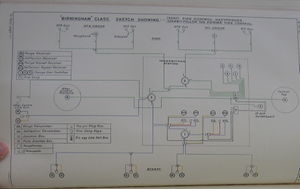Birmingham Class Cruiser (1913)
Three of the four light cruisers of the Birmingham Class (sometimes called the Birmingham subclass of the Town Class) were completed in 1914, but Adelaide was completed in 1922.
Armament
Guns
- Nine 6-in guns; 4 on each broadside and 1 on CL aft.
Torpedoes
Fire Control
As shown in Handbook for Fire Control Instruments, 1914.
Rangefinders
Evershed Bearing Indicators
This equipment was unlikely to have been fitted for gun or searchlight control.[1]
Gunnery Control
Control Positions
There is a control top and a control platform aft with a navyphone connection between them. Both positions enjoy voicepipe connection to the TS.[2]
Control Groups
Each broadside is arranged in 2 groups of 2 guns each. The CL gun aft is a separate group that can be operated independently or assigned to one of either aft broadside group by a C.O.S.[3]
Three 2-way change-over switches in the TS route signals:
- One is fitted in No. 1 group (forward) starboard guns circuit
- One is fitted in No. 1 group (forward) port guns circuit
- One assigns the aft CL gun to port or starboard after group's circuit
When change-over switches 1 or 2 are in their first position, the forward group is worked by its own panel of transmitters in the TS. In position 2, the forward group it is wired to is worked jointly with the aft group on the same broadside. That is, the settings are "split the broadside" or "work the fore group with the aft group".
Navyphones are also controlled by the same C.O.S. system, with telaupads at each gun. Five navyphones are in the TS to address the guns. A pair of navyphones were directly wired between the control top and the after control platform, and both platforms communicated to the TS by voicepipe.[4]
Directors
Birmingham and Lowestoft were fitted with directors in 1917 and 1918.[5] It is likely that Adelaide completed with one in place.[Inference]
Torpedo Control
Transmitting Stations
There is a single TS with navyphones, 3 C.O.S. and 4 sets of transmitters with fire pushes.[6]
Dreyer Table
These ships had no fire control tables.[7]
Fire Control Instruments
Vickers F.T.P. instruments, presumably Mark III.[8][Inference]
See Also
Footnotes
- ↑ The Technical History and Index: Fire Control in HM Ships, 1919, p. 29.
- ↑ Handbook for Fire Control Instruments, 1914, p. 65.
- ↑ Handbook for Fire Control Instruments, 1914, p. 65.
- ↑ Handbook for Fire Control Instruments, 1914, Plate 63.
- ↑ The Technical History and Index: Fire Control in HM Ships, 1919, pp. 11-12.
- ↑ Handbook for Fire Control Instruments, 1914, p. 65.
- ↑ absent from list in Handbook of Capt. F.C. Dreyer's Fire Control Tables, p. 3.
- ↑ Handbook for Fire Control Instruments, 1914, p. 65.
Bibliography
- Template:BibUKARTS1913
- Admiralty, Gunnery Branch (1910). Handbook for Fire Control Instruments, 1909. Copy No. 173 is Ja 345a at Admiralty Library, Portsmouth, United Kingdom.
- Admiralty, Gunnery Branch (1914). Handbook for Fire Control Instruments, 1914. G. 01627/14. C.B. 1030. Copy 1235 at The National Archives. ADM 186/191.
- Template:BibUKDreyerTableHandbook1918
- Template:BibUKFireControlInHMShips1919
